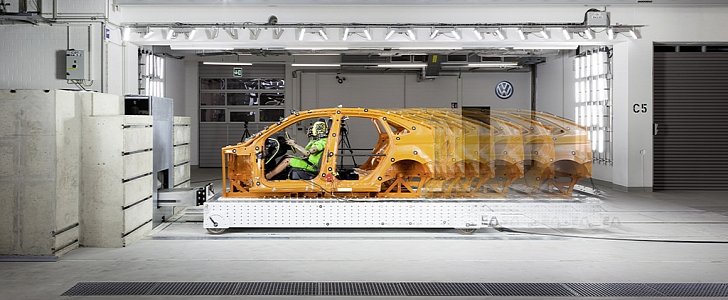The great financial performance of last year has made German manufacturer Volkswagen very optimistic about the future. Despite the backlash of the still ongoing Dieselgate scandal, Volkswagen managed to weather all adversities and is now embarked in serious investments for the future.
One such investment is the creation of a new safety center at the headquarters in Wolfsburg. Spread on 8,000 square meters on three floors (26,200 square feet), the facility will serve as the place where all new VW cars and safety systems will be tested.
The new building will house all of the carmaker’s safety related activities. German engineers have developed a new crash sled, to allow vehicle tests at speeds of up to 100 km/h, with total weights of up to three tons.
The cars will be accelerated on a 140 meters (460 feet) long underfloor cable-rail system and slammed into obstacles. As one test is ongoing, another can be prepared so that the target of 800 sled tests per year is maintained (that’s roughly a little over two crash tests per day).
"This state-of-the-art sled system allows us to reproduce the dynamic movements of a crash as well as simulate so-called 'prebraking' scenarios" said Gunnar Koether, Volkswagen’s head of vehicle safety.
"We can accurately demonstrate the operation of modern active safety systems such as emergency braking in our sled tests."
Aside for the new sled system, the safety facility will host a wider range of related technologies. Volkswagen says it has there multiple test benches, workstations for the development team and a control room.
Sled testing, as the procedure Is called, is a cost-effective way of seeing how cars and parts would survive an impact. Additional systems, like airbag deployment, can also be studied. There are currently two types of sleds for this operation: one that accelerates the car from a standstill and slams it into an obstacle, and another that makes use of a hydraulic ram to simulate impact.
The new building will house all of the carmaker’s safety related activities. German engineers have developed a new crash sled, to allow vehicle tests at speeds of up to 100 km/h, with total weights of up to three tons.
The cars will be accelerated on a 140 meters (460 feet) long underfloor cable-rail system and slammed into obstacles. As one test is ongoing, another can be prepared so that the target of 800 sled tests per year is maintained (that’s roughly a little over two crash tests per day).
"This state-of-the-art sled system allows us to reproduce the dynamic movements of a crash as well as simulate so-called 'prebraking' scenarios" said Gunnar Koether, Volkswagen’s head of vehicle safety.
"We can accurately demonstrate the operation of modern active safety systems such as emergency braking in our sled tests."
Aside for the new sled system, the safety facility will host a wider range of related technologies. Volkswagen says it has there multiple test benches, workstations for the development team and a control room.
Sled testing, as the procedure Is called, is a cost-effective way of seeing how cars and parts would survive an impact. Additional systems, like airbag deployment, can also be studied. There are currently two types of sleds for this operation: one that accelerates the car from a standstill and slams it into an obstacle, and another that makes use of a hydraulic ram to simulate impact.

